January 2023 – Digital transformation leaders WNS have partnered with residential property data specialists WhenFresh to launch a new AI-driven omnichannel ‘Quote & Buy’ platform in the UK, enabling home insurers to deliver improved customer experience and reduced acquisition costs.

The home insurance market in the UK has become highly commoditised, with insurers increasingly reliant on customer experience (CX) to differentiate their offerings. An insurer’s ability to make the customer’s ‘quote & buy’ journey as easy and painless as possible is often the key to winning and retaining customers, improving conversion rates and reducing acquisition costs.
The new WNS HIFFI solution enables insurers to deliver a greatly improved customer experience by providing consumers with much faster, simpler home insurance quotes across a wide range of channels, including WhatsApp, Webchat, Mobile Apps and IVR (Interactive Voice Response).
To obtain an instant, accurate home insurance quote, the consumer need only provide basic personal details and the property address via their preferred channel – then all necessary property attribute and risk data is instantly fetched from the WhenFresh API ‘behind the scenes’ without further manual input. The consumer can then easily accept the quote, make payment and choose their policy delivery preferences within the platform.
The whole process is much shorter and simpler than traditional, long-form insurance quotes, and the platform employs Artificial Intelligence (AI) to understand user intent and either resolve consumer queries or escalate to a live agent when needed.
Mark Cunningham, CEO & co-Founder of WhenFresh states “We’re delighted to be working with the WNS team and this is a perfect example of how digital transformation can be achieved by marrying cutting-edge technologies and accurate data. WhenFresh is the UK’s property data bureau, and our data already powers reduced question-sets for many leading insurers, but the WNS HIFFI solution adds the extra dimension of working across so many different channels to make the frankly rather dull process of obtaining home insurance simpler, faster and even more accessible than before.”
Whilst the customer only needs to provide a few basic contact details and the property address, HIFFI draws on over 30 property and risk attributes from WhenFresh via API, so the underwriting risk selection process is based on a comprehensive, robust dataset. HIFFI is also fully customisable and is an easily integrated, API-based plug and play solution for leading tech and underwriting platforms.
To find out more and arrange a demo, please contact WhenFresh or visit the WNS website.
About WNS (www.wns.com)
WNS is a global business, specialising in driving digital transformation for its clients across multiple sectors. In the insurance space, WNS partner with more than 55 global insurers, re-insurers, brokers and InsurTech companies to accelerate digital transformation – annually managing 30 million+ claims transactions, claims spend worth USD 13 billion and underwriting transactions over worth over USD 10 million. Our deep industry knowledge, leading-edge technology and analytical solutions, and integrated digital operating models help insurers scale faster and respond to changing market conditions. Our digital-first solutions improve risk mitigation, reduce indemnity spending, lower cost of service and enable superior customer experience.
About WhenFresh
WhenFresh is the UK’s leading supplier of residential property data to Banks, Home Insurers, Utilities, The Public Sector and other Big Data users – including 8 of the top 10 UK banks and the Bank of England. WhenFresh combines its own proprietary datasets with 100s of best-in-class private and public data sources in one place to create the UK’s “Residential Property Data Supermarket”. Via a single, simple integration, the WhenFresh API provides users with instant access individual, address-level property attribute, risk, peril, topological, geospatial, environmental, climate, market movement, ownership, title and remote valuations data, on a pay-as-you-go basis. In addition to providing raw data items, WhenFresh provides develops tailor-made, data-driven decisioning solutions and Apps for its clients and was awarded Data Enabling Solution of the Year at the DataIQ Awards 2021, as well as featuring prominently in several prestigious Top 50/Top 100 InsurTech & FinTech reports.
22nd November 2022, London:
InsTech – which describes itself is a leading network identifying and promoting the use of the best technology, data and analytics within insurance and risk-management around the world – has launched the second in its series of major reports on property intelligence in regards to insurance, and WhenFresh are again delighted to feature prominently.
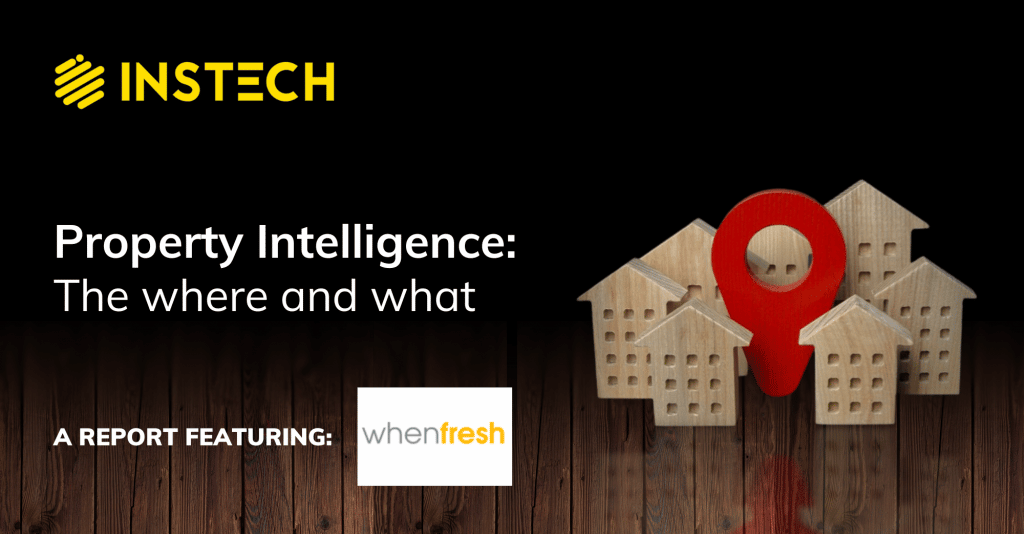
As Ali Smedley, InsTech’s Senior Research Analyst puts it in the new report’s introduction:
‘Last year we released our first property intelligence focused report, Location Intelligence 2021 – the
Companies to Watch. It covered all aspects of property intelligence including location data, property
attribute information, catastrophe modelling and remote claims assessment. This year’s report focuses
only on the “where” and “what” of property intelligence – understanding where a property is located and
what it is made of to help insurers improve risk selection, underwriting and pricing.
‘We covered remote claims in a report released earlier this year. In early 2023 our next report will focus on “what risks do I face”. In relation to property intelligence, particularly focusing on hazard data and modelling. This report reviews the latest trends and technologies in acquiring information for geocoding, building characteristics and rebuild values, as well as profiling the companies we know providing solutions in this space.’
The report is available to download for free, here.
25th October 2022: FinTech Global – leading provider of FinTech news, research, information services & events – has just published its 5th annual InsurTech100 report, featuring WhenFresh for the 2nd year running.
The InsurTech100 Report is described as “an annual list of 100 of the world’s most innovative InsurTech companies selected by a panel of industry experts and analysts… the companies every leader in the insurance industry needs to know about as they consider and develop their digital transformation strategies.”
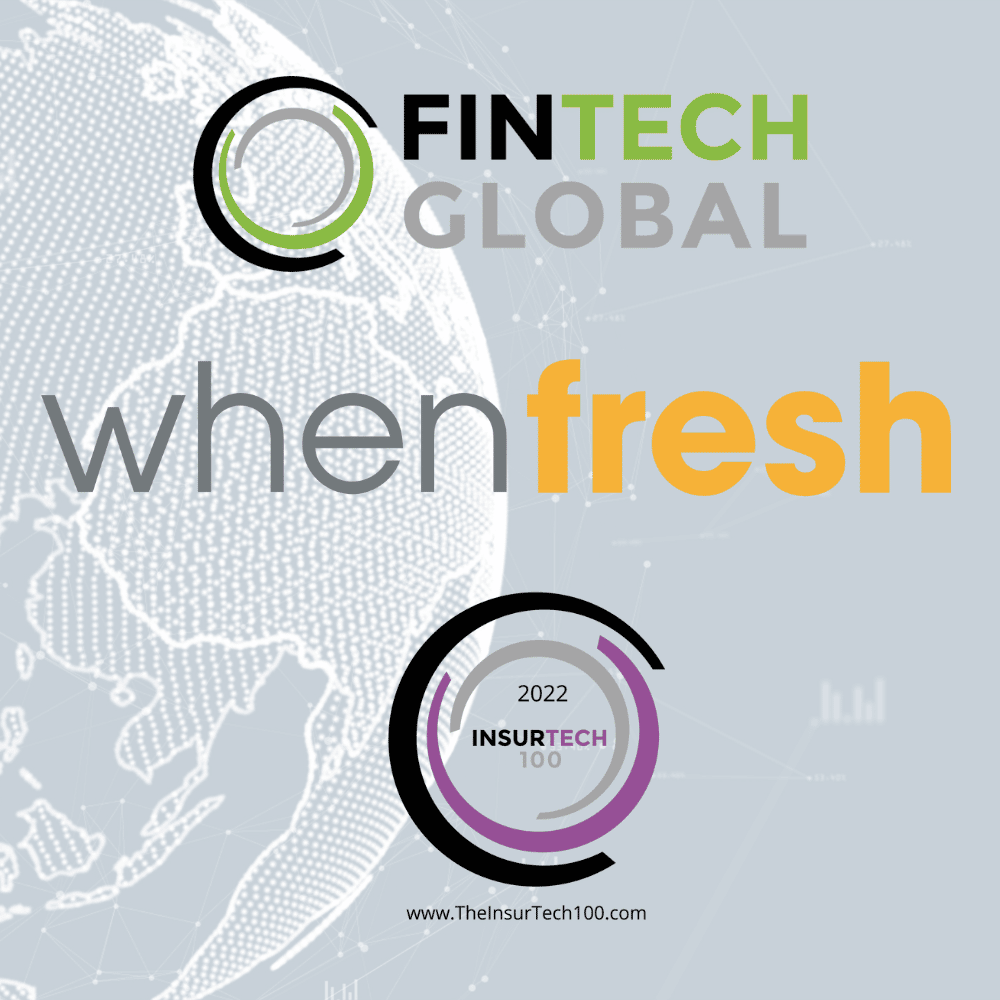
WhenFresh CEO & Co-Founder Mark Cunningham states: “We’re delighted to have again earned our place in this prestigious annual InsurTech100 report, alongside a sparkling array of fellow innovators and disruptors in InsurTech & FinTech! Congratulations to all those who’ve been recognised this year and thanks again to the wise and learned panel of industry experts, analysts and insurers who have chosen to include us again, in such a competitive space. Our large, expanding portfolio of insurance clients are continuously challenging us to source new property-related datasets and tailor-made apps to help them make faster, better, less-risky decisions – and this helps keep up the cutting edge of innovation. We’re looking forward to another highly progressive year!”
The FinTech Global InsurTech100 2022 Report states:
“WhenFresh is an award-winning supplier of property data and related solutions, primarily to UK Home Insurers and Mortgage Lenders. It has created the UK’s “Residential Property Data Supermarket” by bringing together its own proprietary datasets with a huge range of best-in-class private & public property data sources.
Via a single, simple API integration, WhenFresh now provides users with instant access to over 2tn data items, including residential property attribute, risk, peril, topological, geospatial, environmental, climate, market and valuations data, on a pay-as-you-go basis.
WhenFresh customers include leading UK home insurers, 8 of the top 10 mortgage lenders, the Bank of England and disruptive players in insurance and lending, such as Uinsure, Locket, Twenty7Tec and MQube.
As well as supplying ‘raw’ data ingredients, WhenFresh develops customised Apps which enable insurers and lenders to interrogate its huge data assets easily and instantly via rules-based engines, to make faster, smarter, less-risky remote decisions.”
Congratulations to all the insurtech & fintech innovators featured in this influential report, which can be downloaded for free at: https://TheInsurTech100.com
To find out more about WhenFresh, try the new “Mini-Demo” below to see a selection of some of the residential property data items that leading Insurers & Mortgage Lenders most commonly call from the WhenFresh API to support their automated decisioning. WhenFresh are able to supply these data items and many, many more for virtually every residential property in the UK.
[formsite host=”fs27″ key=”m_OmK8apOTDFAj315ZTI88eLrX2OJLdKFzpUCZwnDno” width=”100%”]
26 July 2022: Insurance data intelligence provider, Percayso Inform, today announces a new partnership with the UK’s leading supplier of residential property data, WhenFresh, to support the further development of Percayso’s property data capabilities for providers of household and SME insurance.
WhenFresh has combined its own proprietary datasets with hundreds of best-in-class private and public data sources in one place to create the UK’s “Residential Property Data Supermarket” for the UK insurance industry, mortgage lenders and other Big Data users.
Ian Lilley, Head of Partnerships at Percayso, says: “As we extend our services into both the household and SME commercial space, we want to be able to provide not just data but also analytical intelligence to our customers. WhenFresh shares the same ethos. The WhenFresh API gives instant access to over two trillion property-specific data items and can instantly return all the property attribute, risk, perils environmental and valuations data an insurance provider needs.
“There are a lot of synergies between our businesses. Like us, they’re constantly looking to add new datasets to anticipate market demand, but more importantly are willing to share their vast experience and knowledge to help analyse and advise on bespoke customer datasets. They’re more than purely a data supplier, rather a solutions provider. We’re looking forward to building a long-lasting partnership.”
WhenFresh CEO Mark Cunningham adds: “We’re delighted to be working with Ian and the Percayso Inform team to support their growth in the home and SME insurance sectors – and we’re sure our partnership will open some very interesting doors for both parties. Like Percayso, WhenFresh is a data agnostic business, so we often hold a number of different brands of data in the same category… so the user can choose their preferred option and/or other brands to suit their needs, in whatever format they require.
“Putting vast, readily accessible data assets, alongside the analytical capabilities and tools to deliver clear business improvements, into the hands of insurers, makes this a highly compelling proposition.”
Read the full Insurance Times article here
[formsite host=”fs27″ key=”m_OmK8apOTDFAj315ZTI88eLrX2OJLdKFzpUCZwnDno” width=”100%”]
About WhenFresh
WhenFresh is a leading supplier of residential property data to UK Insurers, Banks and other Big Data users. Combining its own proprietary datasets with 100s of best-in-class private and public data sources in one place, WhenFresh has created the UK’s “Residential Property Data Supermarket”. WhenFresh also develops tailor-made, data-driven decisioning solutions and Apps for its clients and was awarded Data Enabling Solution of the Year at the DataIQ Awards 2021, as well as featuring prominently in several prestigious Top 50/Top 100 InsurTech & FinTech reports.
About Percayso Inform
Percayso Inform’s insurance intelligence goes beyond traditional data enrichment, providing unique, real-time solutions at all stages of the insurance lifecycle and delivering a significant pricing advantage for insurance businesses.

The addition of MyShawbrook bridging will “streamline the entire bridging application process”, according to the lender.
Brokers will be able to access instant integrated valuation and credit-backed heads of terms. They can also instruct solicitors during the agreement in principle stage.
The portal has a maximum loan calculator so brokers can get a better understanding of how much Shawbrook can lend to customers, even if there is more than one loan requested.
Alongside the integration of WhenFresh property data, Shawbrook’s portal also has integrations with Experian, Companies House and other sources, which it says will reduce the need to input extra data and documentation. Read more…
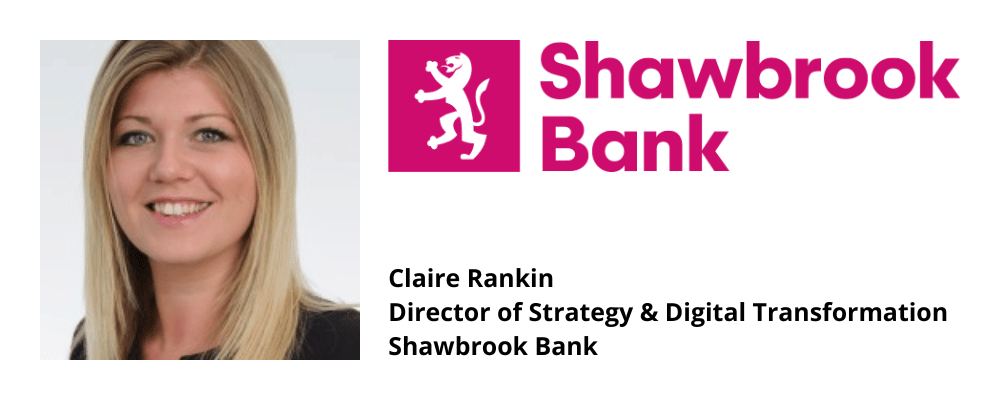
[formsite host=”fs27″ key=”m_OmK8apOTDFAj315ZTI88eLrX2OJLdKFzpUCZwnDno” width=”100%”]
Nottingham, UK, 15 February 2022
● WhenFresh and Connected Data partnership will inject valuable property related insight into key processes to enable timely and more appropriate customer engagement
● WhenFresh, creators of the UK’s ‘residential property data bureau’, is the latest leading UK data provider to partner with Connected Data
UK households are facing a ‘cost of living’ crisis and organisations across all sectors are preparing for record levels of debt. These organisations are striving to better understand where and when debt will occur, and to ensure they treat customers fairly whilst looking to resolve their arrears.
WhenFresh, an award-winning supplier of property data and related solutions to the UK’s leading home insurers, mortgage lenders, public sector and other big data users, has partnered with data driven technology company, Connected Data, to provide a valuable dimension to the way debt is understood and managed by organisations in the UK.
WhenFresh has created what it refers to as the UK’s ‘residential property data bureau’ by combining over 200 proprietary, private and public UK datasets (e.g. residential property attributes, risk, peril, topological, geospatial, environmental, climate, market and remote valuations data) with advanced analytics, all in one place.
With the aim of achieving positive engagement and fairer outcomes for indebted customers, this exciting partnership will enable organisations to better understand an individual’s circumstances and potential level of affordability through property related data. WhenFresh’s address level insight will enhance the in-depth intelligence Connected Data already provides on individuals, powered by its relationship with several leading data providers.
Paul Rout, Senior Vice President at WhenFresh, said: “The UK’s leading home insurers, mortgage lenders and disruptors to the market see the significant value of the insight we provide in their lending decisions and insurance quotes. We also recognise the potential of these residential property data assets in the management of debt, and their specific role in timely and appropriate engagement. Combining property data with traditional debt management data assets creates powerful insights into debtors’ circumstances, a process which Connected Data are very well placed to do.
“Connected Data is already disrupting the way UK organisations manage debt with a clear focus on ensuring positive outcomes for all parties. They were the natural choice for us as a partner and we are excited about the positive impact our partnership will have.”
Kirk Fletcher, Founder and CEO of Connected Data, said: “Our goal is to enable organisations to engage with their customers in an informed way with as much relevant insight on their circumstances as possible. It will always enable a better conversation and a fairer debt journey for the customer, as well as optimise an organisation’s processes.
“WhenFresh’s data provides a new and vital element to an organisation’s understanding of its customers’ circumstances. And they have a clear mission to ensure the person at the end is treated fairly. We are delighted to be partnering with them.”
As the latest data partner to work with Connected Data, the partnership with WhenFresh continues to highlight how the company is bringing innovation to the way organisations manage their debt portfolios. By integrating different datasets from multiple leading data providers, not only is Connected Data enabling organisations to achieve the most in-depth insight possible, but it is removing ‘data noise’ – a significant barrier for organisations seeking to better understand and connect with their customers.
Read more at CCR Magazine
About Connected Data
Connected Data transforms an organisation’s insight across its debt management process, simplifying the deployment of predictive data, removing data noise and identifying opportunities to prevent and reduce debt across its organisation. Connected Data works in partnership with UK leading data solutions providers to truly data enable debt management processes.
About WhenFresh
WhenFresh is a leading supplier of data to Financial Service sector, public sector and other Big Data users, including 8 of the top 10 UK banks and the Bank of England. WhenFresh has built the UK’s “Residential Property Data Bureau”, by bringing together over 200 proprietary, private and public UK data sources in one place. Via a single, simple integration, the WhenFresh API provides users with instant access property attribute, risk, peril, topological, geospatial, environmental, climate, market movement, ownership and remote valuations data, on a pay-as-you-go basis. WhenFresh were awarded Data Enabling Solution of the Year at the DataIQ Awards 2021 and feature prominently in a number of prestigious “Top 100” FinTech and InsurTech reports.
London, 12 November 2021: As the COP26 summit in Glasgow draws to a close, property data specialists WhenFresh have announced a major extension to their climate change offering by making Ambiental’s FloodScore™ Climate data suite available via its award-winning API.
Ambiental’s FloodScore™ Climate enables the (re)insurance and banking sector to respond to the Bank of England’s regulatory requirements and also general business future-proofing. It does this by providing individual property-level flood risk scores, both for the present day and the 2050s and 2080s, based on low, medium, and high emission scenarios as defined by UKCP18 (the UK Climate Projections).
The move follows the integration of Ambiental’s FloodScore™ back in February, where each UK property is given a measure of the likelihood and severity of a flood hazard affecting it from fluvial, pluvial, and tidal sources.
The FloodScore™ Climate data provides the means for mortgage lenders, insurers, and other parties to assess current and future flood risk data for more accurate analysis of risk within existing portfolios, to meet both commercial needs and their regulatory obligations.
Rob Carling, Ambiental’s Channel Sales Manager, said: “We are pleased to extend our partnership with WhenFresh by adding our FloodScore™ Climate dataset to their highly regarded API. “The demand from the financial sector for accurate data has increased significantly over the last few years,” he continues. “We expect this trend to continue following the Bank of England’s strategic focus on climate change risks, and new legislation coming into force from April 2022 that makes it mandatory for firms to disclose climate-related financial risks and opportunities.”
Mark Cunningham, co-founder and CEO of WhenFresh adds: “It’s a great step forward for us to have Ambiental’s FloodScore™ Climate data alongside the ever-growing stable of property attribute, risk, peril, environmental, geospatial, topological, and valuation datasets we make available through the WhenFresh API.
“Our aim has always been to make best-in-class datasets such as this easily accessible to end users to remove the barriers to digital transformation – and we’re seeing a solid increase in the use of climate and environmental data among insurers, banks, and other big data users, not least for regulatory reasons.”
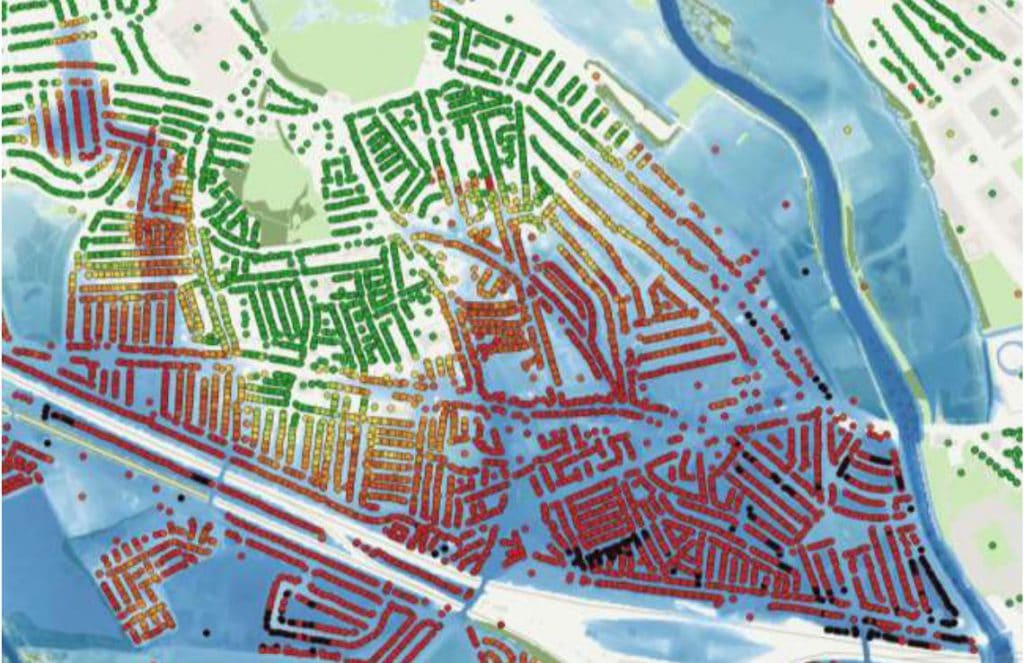
rating value
About WhenFresh
WhenFresh (www.WhenFresh.com) is a leading supplier of data to UK Lenders, Insurers, and other Big Data users, and provides the UK’s Residential Property ‘Data Supermarket’, which brings together over 200 proprietary, private, and public UK data sources in one place.
Via a single, simple integration, the WhenFresh API provides users with instant access over 2tn data items, including property attribute, risk, peril, topological, geospatial, environmental, climate, market, and valuations data, on a pay-as-you-go basis.
WhenFresh were awarded ‘Data Enabling Solution’ of the Year at the DataIQ Awards 2021 and feature prominently in a number of prestigious ‘Top 100’ InsurTech reports.
About Ambiental Risk Analytics
Ambiental Risk Analytics, a company of Royal HaskoningDHV, is a global specialist in environmental hazard intelligence, predictive analytics, and risk management. Ambiental provides flood forecasting systems using flood modelling techniques that support better decision-making around flood and climate risk management by predicting the location and severity of flooding, preventing damage, and protecting people, property, and assets. It is Ambiental’s belief that all people, property, and capital should be resilient to flooding and climate change risks. Ambiental was founded in 2002 and became part of Royal HaskoningDHV in 2019.
A great interview by Matthew Grant of the excellent Instech London, with WhenFresh co-founder Mark Cunningham. Key talking points include:
> Why insurers should embrace pre-fill
> Getting trusted data during Covid-19
> Identifying new sources and partners
> Moral hazards and customer experience
> The hidden costs in property valuations
> Why “WhenFresh” rather than “ArtificialElephant”
Please listen to the podcast, or read the highlights transcript below.
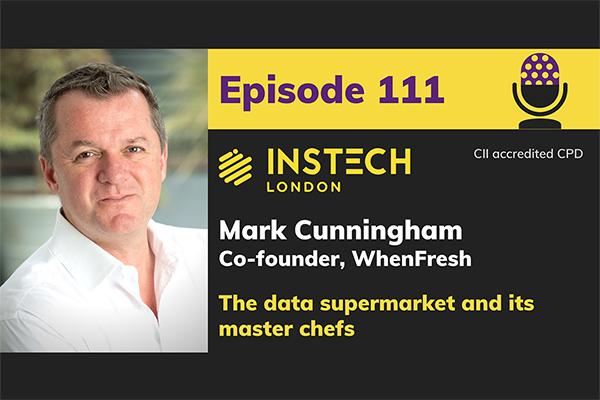
The Data Supermarket and it’s Master Chefs – Podcast highlights:
Matthew: Mark, you founded your first company in 2006 and sold it in 2011. You also developed a music search library before setting up WhenFresh in 2012. How did you end up in insurance?
Mark: We took the data warehousing and search capability from the music search business and looked at where else we could apply it. My co-founder, Alan Dean, came from an insurance technology background. He was with Swiftcover and Microsoft and Tesco before that. We found nobody else was doing this kind of data rendering in insurance.
The last year has been a sea change in how people use information to make distance decisions. Remember when we used to go and meet people? We can’t do that now, so we need to look for data elsewhere.
Matthew: This concept of WhenFresh being a data supermarket. What are you offering to insurance companies?
Mark: It depends on the company. Typically, a company would say their pricing team needs to know certain things, e.g. proximity to water, a previous flood event, building height. They want to know that the data is right and is it available quickly?
Matthew: Once you’ve got the data, who does the analysis?
Mark: We do it in-house through Alan, our Head of Data Ken Clemmer, and Seb London. Seb was the head of API development at comparethemarket, so we have three expert checkers. Think of it as a restaurant. They’re the chefs creating and checking the food’s right.
Each of the data items comes from a provider, we work with what we think are the best companies, whether it’s satellite imagery out of the University of Liverpool or work from Cranfield University or the European Space Agency.
Matthew: There’s so much free data out there. Are companies providing your paid-for data, and can your team add value from free sources?
Mark: Free data can actually be really expensive. If it’s not properly processed, people make the wrong decision. What we’re looking for is provenance. Can I bind the free data to an address or map reference? That’s tricky and using free data incorrectly can cause real trouble.
Matthew: You’ve done something quite clever with data from Zoopla. What is it that you’re providing?
Mark: They’re a key strategic partner and we extract key value elements from their descriptions of properties. Think of it as two particularly useful outcomes. One where an agent accurately describes something, and one where they accurately describe something that hasn’t been described before. A loft conversion, or a basement or side return that doesn’t appear on planning data or isn’t visible in imagery data. We know someone has sent a human to have a look so that data is really useful in the insurance space.
Matthew: That’s one of the challenges with data, particularly with properties. People make changes all the time which can impact the value.
Mark: Zoopla has been a very good source; as have planning data and imagery data providers. We aggregate those to build a patchwork that gives a much better view. If Zoopla, the planning application and the loan application say it’s a four-bedroom house, then it’s a four-bedroom house.
Matthew: There will sometimes be different views though, so is the challenge making a decision based on the different sources available?
Mark: We have to be careful about how we interpret data. I’m sitting in a room which is designed as an office but was formerly a bedroom. I had my house valued and they told me I had a three-bedroom house, but it’s a four-bedroom house. It doesn’t have to have a bed in it to be a bedroom.
Another example is I can describe a bungalow that’s an end of terrace as also being semi-detached and also a bungalow. Which one’s right? We’ve got to know what the insurer needs, then recode the data in accordance with their flavour.
Matthew: You also provide choice, rather than saying, ‘this is the WhenFresh view, take it or leave it.’
Mark: The insurer drives the decisions and they need to know the source of the data. Going back to the supermarket analogy, a customer has got to be able to walk along the shelves and choose which brand of corn flakes they want.
The essence of our business is delivery in a way that gives insurers confidence. We should be the least exciting company they’ve ever come across, because what they asked for turned up exactly when expected and it does exactly what we said it would do.
Matthew: Are you doing any crowdsourcing of opinions of which data people prefer? Rather like the Netflix model of ‘if you liked that, you’ll like this.’
Mark: The market is small enough that I’m not sure we have the same gravity traction in terms of usage, but it’s a very good point. Two of our biggest customers now give us corrected data where a customer has told them that something isn’t true and we update our model. Using them as an ingredient source is in effect crowdsourcing. A customer with 1.5 million policies helps infer what the truth is on the data.
Matthew: Is there’s a little bit of moral hazard where people, for whatever reason, change the way their property is defined?
Mark: That’s a good question. How do we avoid the moral hazard if somebody’s deliberately re-coding? Just like moral hazards in car quotes, when people say they park in the garage and they see the price change, there are interactions with customers which change the opinion about their home.
We have multiple sources to check against. They say it’s a cottage, but I can see a picture of it and it’s a block of flats and I know Barclays lent the mortgage to them. We’re looking for subtle inflexions. One thing is affecting price and the other is delivering a good user experience. We can do both without necessarily challenging the moral hazard.
Matthew: How do insurers connect to the WhenFresh database?
Mark: Either through APIs, a combination of API and flat files, or just flat files. For us, it’s more important that the data is right than it being fast. It needs to be well considered and prudent, so we’re helping insurers reduce loss ratios.
Providing the right information doesn’t always mean having to send it out by API, sometimes it means giving an insurer a file to run locally. That’s good, that’s not a problem. We roll with whatever people are using and if it’s a legacy system, we’ll work around it.
Matthew: And you offer test access to your data via an API to let people try before they buy. How does that work in practice?
Mark: It’s usually done in two stages. The first is identifying the data the insurer needs. Typically, they might say, ‘I have 1,000 policies and I’ve suffered a loss on some of them. Can your team append them with everything WhenFresh knows?’ We’ll work with their analyst or lend them an analyst to identify common factors to avoid or price differently.
Then we either provide access to the API or a flat file of all of the releases in the UK where that ingredient is true. They can test it on the sandbox to see in real-time if the thing they don’t like is present in a candidate seeking insurance.
Matthew: There’s a big move towards reducing the number of questions customers have to answer to take out insurance. How confident can insurers be that the data that comes back is accurate?
Mark: There’s a new bank using a hook up to our API where they aren’t sending out any physical evaluations or surveys. It means there isn’t someone doing a virtual visit to collect all the other data, questions around Japanese knotweed, condition, plot size, restrictions. But we do and working with our partner CLS we’re able to merge the data sets to produce an insurance wrapped data block. That means our customers can take out loans in three hours. Not just the approval, they could actually deposit the cash.
They don’t need to send out a valuer to look, they don’t need to send out a survey. They can hit our combined APIs and check 75 different fields on the shape of the roof, quality of windows, presence of Japanese knotweed, proximity to water. The insurance wrapper also covers the conveyancer, so the collector doesn’t need to run those checks. They can go straight to lend.
Matthew: So, you’re offering the data for valuations and an insurance product covering incorrect valuations?
Mark: There are two products. One is called Verify, which judges whether the value of something is correct. If a bank lends on it and they have to repossess the property because it turns out the value was wrong, the insurance covers that risk. As a result of Covid-19, the real problem is not the valuation but the condition. We work closely with Hometrack to provide an insurance policy that sits behind the valuation. That’s not the difficult bit, the difficult bit was no longer being able to send a surveyor.
Any insurance company not using prefill is missing a trick. There’s no point in asking somebody a question we already know the answer to. Going back to moral hazards, there’s no point in asking my mother how tall the nearest tree is. She’s 82, she wouldn’t know. We’ve got the satellite imagery, so we know how big the tree is. But are we willing to risk a mortgage based on that data? Not only are we sure, we’re so sure we’ll insure it. We’ve moved out of just selling to insurers into using data to build insurance products for insurers.
Matthew: We’ve been talking about building valuation, but from the insurance perspective, it’s the rebuild costs that are important. Are you also tracking that?
Mark: Yes we are. One of the rebuild costs that often gets overlooked, but we’ve found a really good way of doing it, is alternative accommodation. I was talking to an insurer yesterday morning about the challenges around exactly that. There are models for handling flood and remediation in the event of flood damage, but the cost of rehousing somebody during repairs is part of that. Insurers need a map of all the things that are rentable, that approximate to all the things insured.
That’s what we’re getting into with the rebuild cost. It’s not just the bricks, the cost of local builders or dealing with the local authority. It’s also about what happens to the customer during the work.
Matthew: UK insurers are less demanding on policyholders to define the rebuild costs. Does that increase the value of what you’re offering to clients?
Mark: The challenge we see is insurers using a current market valuation of a property as a proxy. It’s true except in circumstances where it isn’t. Imagine a £100,000 mid-terrace unit that is catastrophically damaged. There could be £200,000 worth of damage if it’s sitting in between two other houses.
Frankly, the value of the thing is also not the same if it’s reduced to rubble. Its value is not minus, it could be minus some number of hundreds of thousands of pounds. We need to know the value of those things and figure it out from there.
Matthew: What can you tell us about the work WhenFresh is doing with the Bank of England?
Mark: We are looking at changes in valuation over populous. What things are out there that are buildings and what are they worth? The BoE uses that data in their macroprudential reports and it’s not a secret that the report that came out in April quoted analysis we had done. That’s what we’re doing at a high level. It’s a bit more than that, but that’s their IP, not mine.
Matthew: Is there anything else that we should be keeping an eye out for from WhenFresh in the next few months?
Mark: I would look out for our combination of data and insurance as a product. The valuation is taken off the AVPS, which is what we use to insure a building so companies can lend on it. There’s more stuff coming to watch.
Also, I’m looking forward to seeing people again. The people we met at InsTech London events were always phenomenal. I hope we get back to that safely as soon as possible. I miss our Tuesday evenings.
Matthew: One final question, where does the WhenFresh name come from?
Mark: To find that out, people need to listen to your podcast!
07 Feb 2020: Joanne Atkin of Mortgage Strategy Gazette reports on why M:Qube is different…
M:Qube is about to launch into the mortgage market but it is no ordinary lender – it’s a fintech business first and a mortgage lender second…
… Tony Connell, chief product officer, with a tech background at FICO, Visa Europe, Experian and Royal Mail, explained how the system is a data driven process with real time decisioning: “First, we assesses the property the borrower wishes to buy.
“The system accesses 140 points of data on a property using various sources such as four AVM providers, the Land Registry, Rightmove and Whenfresh to gain a myriad of information. This would include the method of construction, square footage, number of rooms and floors, flood and subsidence risk and so on.
“This gives a clearer picture as to which lenders would lend on the property and if indeed it is mortgageable. Data on the borrower is then collected, categorised and verified followed by real time underwriting.”…
Read the full article here or visit Mortgage Finance Gazette.

(Courtesy of Mortgage Finance Gazette)


